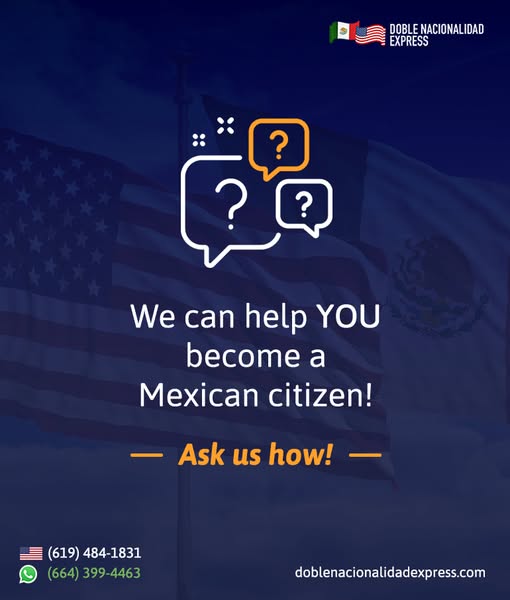Getting a work visa in Mexico requires employer sponsorship, an application at a Mexican consulate, and follow-up at immigration offices in Mexico.
This guide explains step-by-step how U.S. citizens and other foreigners can apply, plus what to do if you want to later transition to residency or dual citizenship.
Once you secure a job offer from a Mexican employer, the process begins with Mexico’s National Immigration Institute (INM), followed by a consular appointment, and then a final step inside Mexico to exchange your visa for a resident card.
Costs are modest, usually under $400 USD, and approval depends on employer registration and document accuracy.
We have helped thousands navigate these same steps. Our licensed attorneys simplify complex requirements, prevent costly rejections, and even explore faster alternatives like family-based residency or dual nationality.
If you want the full breakdown, keep reading.
Below, we will walk through the process, answer common questions, and show you how to avoid the pitfalls that slow down most applicants.
The Basics: How to Get a Work Visa in Mexico
A Mexican work visa is not something you can apply for on your own.
It begins with a job offer from an employer in Mexico who is registered with the National Immigration Institute (INM).
Only the employer can request permission to hire you; once approved, you will receive a case number (NUT) that allows you to continue at a Mexican consulate abroad.
Required Documents
At the consular stage, you will need to present:
- A valid passport with at least six months left before expiration.
- A printed visa application form and recent passport-sized photos.
- The official job contract or offer letter from your Mexican employer.
- Proof of qualifications, such as diplomas, CV, or licenses.
- The NUT approval letter from INM.
- Consular fees, typically ranging from $150–$300 USD.
If your documents were issued outside the U.S. or Mexico, they often require an apostille or legalization and certified Spanish translation.
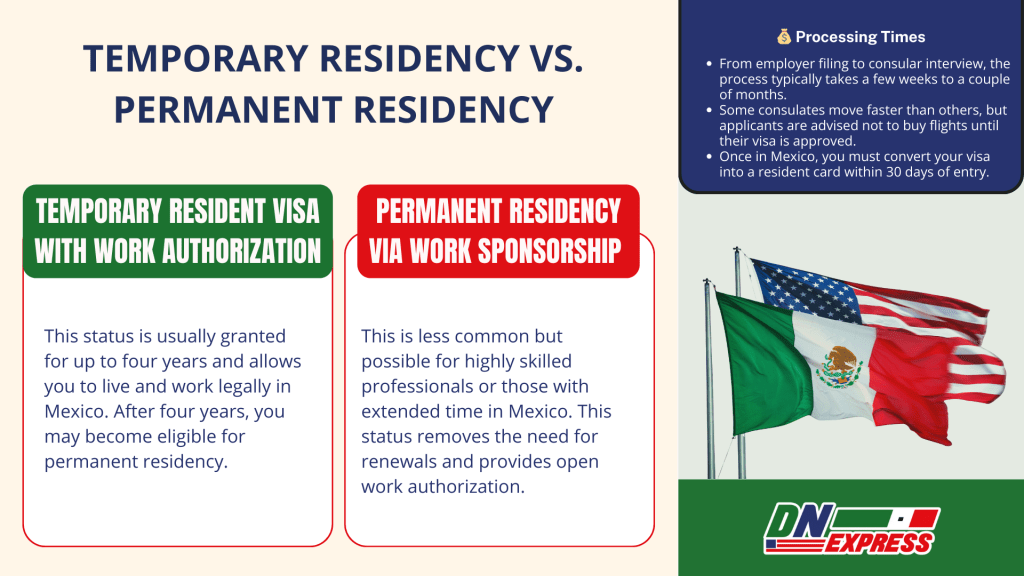
Temporary Residency vs. Permanent Residency
Temporary Resident Visa with Work Authorization
This status is usually granted for up to four years and allows you to live and work legally in Mexico. After four years, you may become eligible for permanent residency.
Permanent Residency via Work Sponsorship
This is less common but possible for highly skilled professionals or those with extended time in Mexico. This status removes the need for renewals and provides open work authorization.
Processing Times
From employer filing to consular interview, the process typically takes a few weeks to a couple of months.
Some consulates move faster than others, but applicants are advised not to buy flights until their visa is approved.
Once in Mexico, you must convert your visa into a resident card within 30 days of entry.
Step-by-Step Application Process
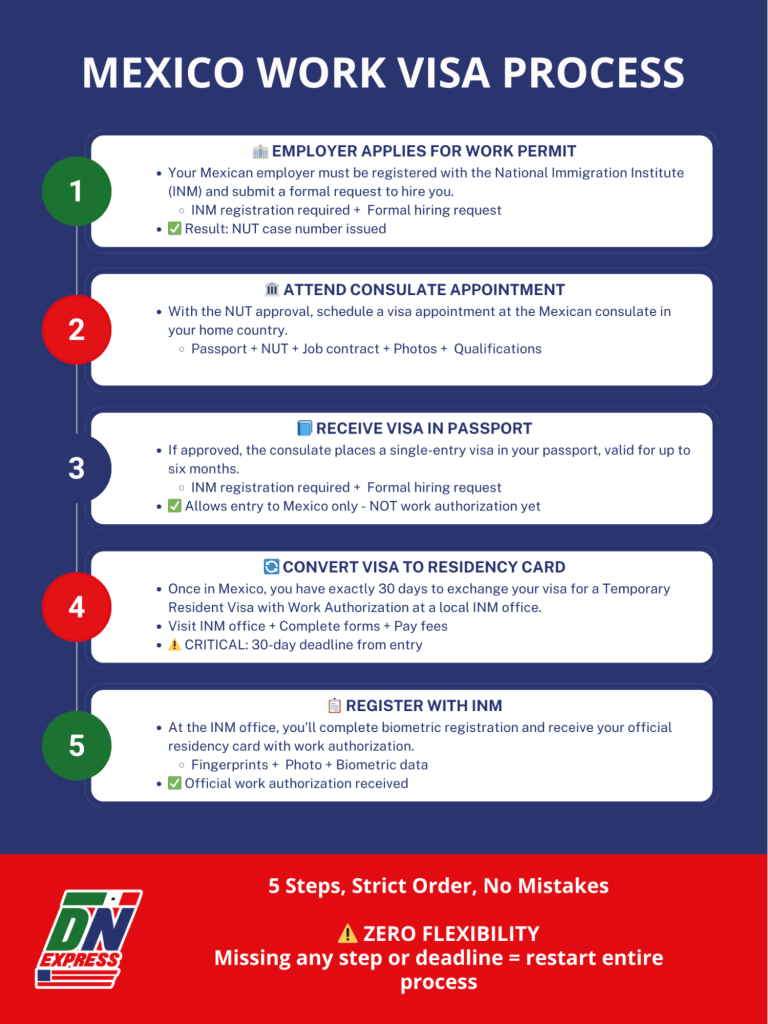
Getting a work visa in Mexico follows a strict sequence.
Missing a step or deadline can set you back months, so here is what to expect:
1. Employer Applies for Work Permit in Mexico
Your Mexican employer must be registered with the National Immigration Institute (INM) and submit a formal request to hire you. If approved, INM issues a case number (NUT) that you will use at the consulate.
2. Attend a Consulate Appointment
With the NUT approval, you schedule a visa appointment at the Mexican consulate in your home country. Bring your passport, application form, job contract, photos, and proof of qualifications. Officers may ask for additional documents, so be prepared.
3. Receive Visa in Passport
If approved, the consulate places a single-entry visa in your passport, valid for up to six months. This visa allows you to enter Mexico to complete the process.
4. Convert Visa to Residency Card
Once in Mexico, you have 30 days to exchange your visa for a Temporary Resident Visa with Work Authorization at a local INM office. Skipping this step can invalidate your visa and force you to restart the process.
5. Register with INM
At the INM office, you will be fingerprinted, photographed, and issued a residency card with work authorization. This card is what legally allows you to live and work in Mexico.
Worries People Have About Work Visas (and Solutions)
Even qualified applicants often feel anxious about the work visa process.
That is because immigration rules are complex, consulate procedures vary, and one mistake can derail months of planning.
Here are the most common worries and how to solve them.
- Fear of Rejection Due to Paperwork Mistakes. A missing apostille, name mismatch, or untranslated document can cause immediate rejection.
- Solution: Have a legal team review your documents before submission. We specialize in catching and fixing these errors so you do not waste time or money.
- Frustration With Consulate Delays. Some consulates are backed up for months, while others require extra documentation at the last minute.
- Solution: Plan well in advance, and use professionals familiar with each consulate’s quirks. We know how to navigate shifting requirements and keep your case moving.
- Uncertainty About Converting Tourist Stays Into Work. Many assume they can “switch” from a tourist visa to a work visa inside Mexico, but that is not allowed.
- Solution: Start the process correctly from abroad. If you are already in Mexico, we can evaluate alternative legal pathways like family-based residency or economic solvency.
- Employer Withdrawal or Miscommunication. Some employers back out after promising sponsorship or are unclear on their obligations with INM.
- Solution: Work with legal professionals who can confirm your employer’s compliance and protect your application. We ensure your sponsorship is legitimate before you commit.
Work Visa vs. Other Legal Pathways
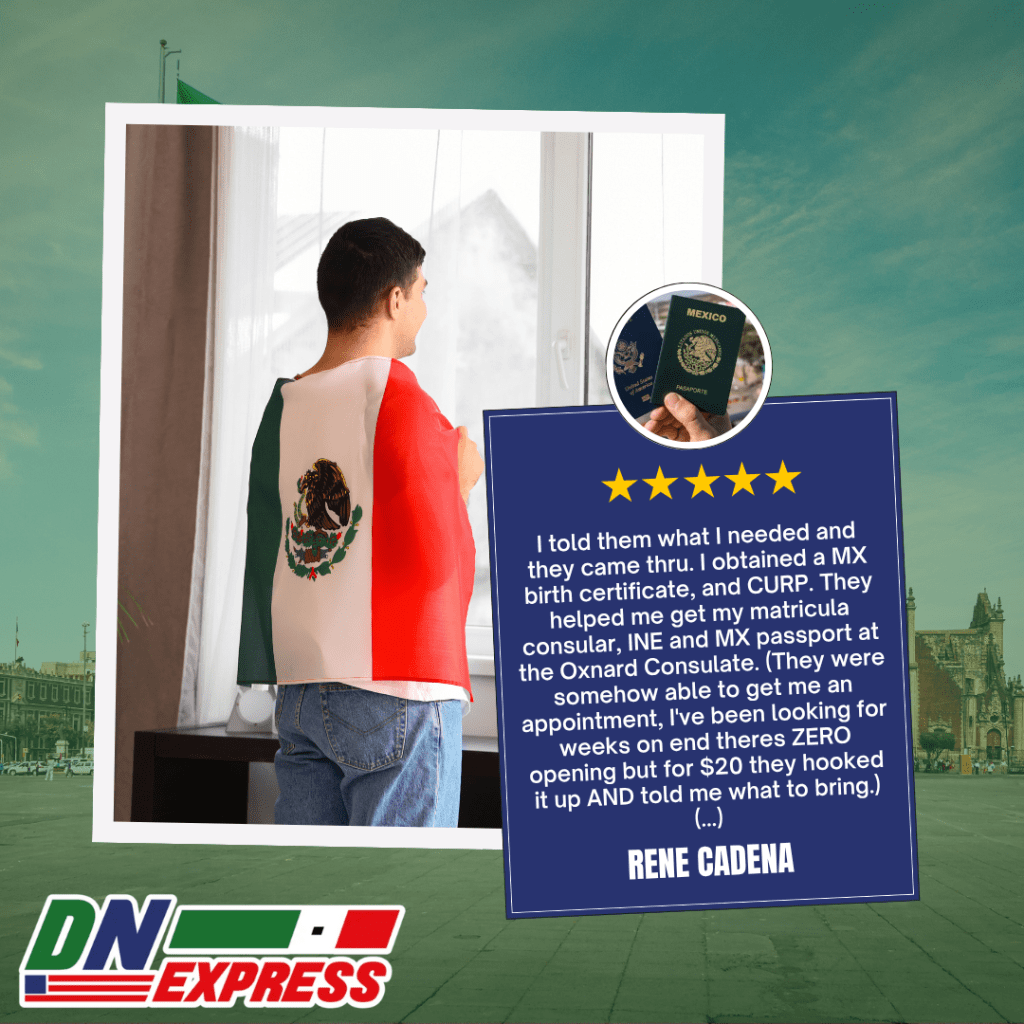
A Mexican work visa is not the only way to live and work legally in Mexico.
Depending on your background, other pathways may be faster, less restrictive, and more permanent.
Work Visa
- Best for: Foreigners with a valid Mexican job offer.
- Pros: Direct authorization to live and work. Renewable up to 4 years.
- Cons: Employer-dependent, requires consulate processing, and you must renew until eligible for permanent residency.
Family Residency
- Best for: Spouses, children, or parents of Mexican citizens.
- Pros: No employer sponsorship required, faster processing, and fewer restrictions on work authorization.
- Cons: Must prove the family relationship with official Mexican documents, often needing corrections or recovery.
Dual Citizenship
- Best for: U.S.-born children or grandchildren of Mexicans.
- Pros: Full citizenship rights: no visas, no renewals, and no work restrictions. Includes the ability to own property without a trust, vote, and pass citizenship to children.
Cons: Requires document recovery and correction, but once secured, it is permanent.
Why Some People Skip Work Visas Entirely
Many U.S.-born children of Mexican parents qualify directly for nationality.
Instead of applying for a work visa, they reclaim their heritage and bypass the consulate process entirely.
This gives them the same rights as any other Mexican citizen.
Case Study: Career Expansion Through Dual Nationality. One professional client began with a Temporary Resident Work Visa through her employer. After learning her parents were born in Mexico, she reclaimed her dual nationality.
This not only removed the stress of renewals but also gave her access to opportunities in both countries, boosting her career internationally.
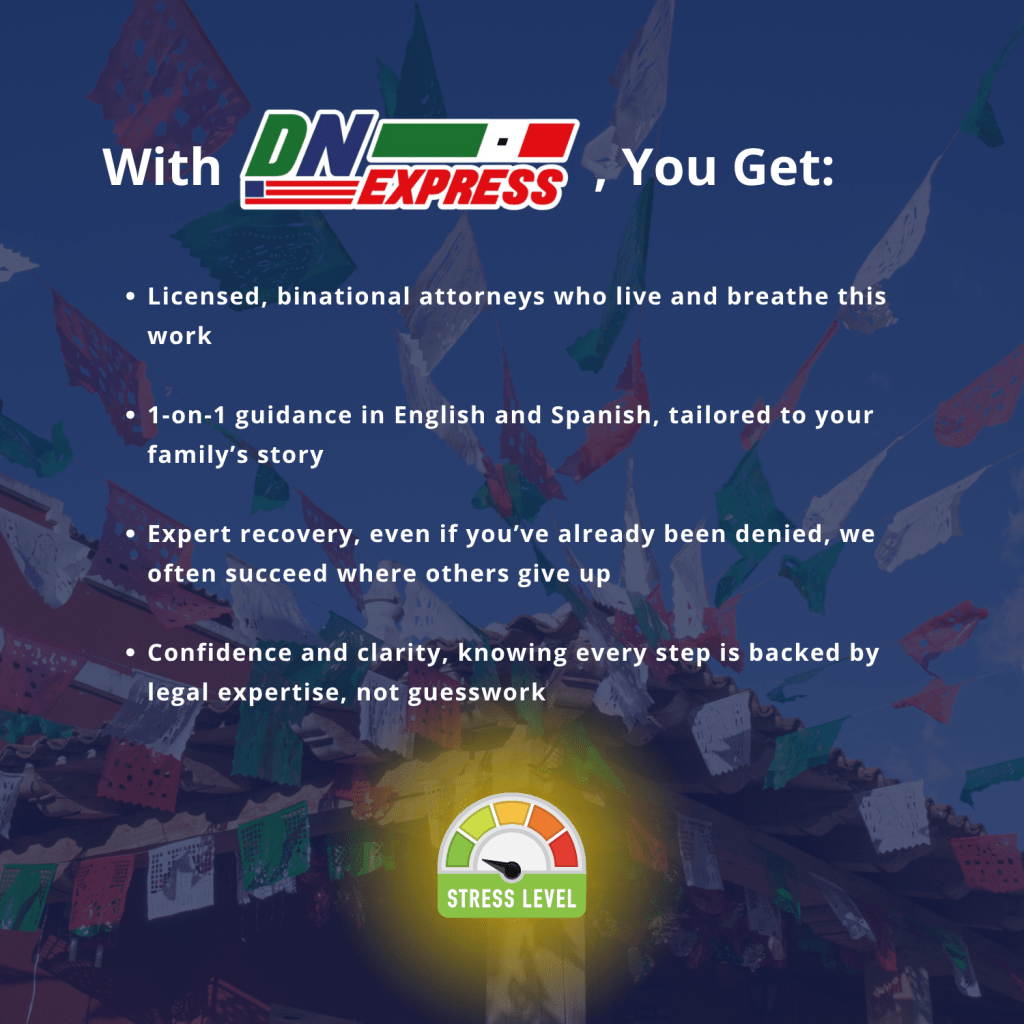
Why Work With a Professional Service Instead of DIY
Applying for a Mexican work visa on your own can feel like running through a maze. Every consulate has different rules, requirements change without notice, and one clerical mistake can set you back months.
We have built a system to eliminate that stress.
- Consulate-Free Solutions. We do not make you wait endlessly for consulate appointments. Our licensed attorneys handle the process directly, giving you faster, more consistent results.
- Licensed Attorneys, Not Just Paper Pushers. Unlike document processors, our cases are reviewed and managed by licensed Mexican attorneys who are proficient in both U.S. and Mexican legal systems. That means your application is backed by legal authority.
- Affordable, Transparent Pricing. We believe immigration services should be accessible. Our fees are fixed, fair, and transparent, with no hidden charges or surprise add-ons.
- Specialists in Tough or Rejected Cases. Were you told “no” before? That is often where we shine. We have turned hundreds of denials into approvals by correcting records, fixing mismatched names, and reopening rejected cases.
- Worldwide, Remote Support. Whether you are in California, Texas, Illinois, or abroad, we can help you apply remotely. No travel, no consulate lines, just a clear, guided path to work authorization or even citizenship.
Downsides of Doing It Yourself
It is possible to apply for a Mexican work visa on your own, but many people discover the hard way that small mistakes carry big consequences.
Here are the risks you should be aware of before going the DIY route:
- Lost Time From Document Errors. One of the most common setbacks is missing an apostille, mistranslating a record, or having mismatched names across documents. Even a single typo can force you to restart the process.
- Consulate Inconsistency. Not all consulates follow the same checklist. One may approve an application with minimal paperwork, while another demands extra documents. Without experience, it is difficult to predict what your specific consulate will require.
- Risk of Denial and Restarting. If your application is denied, even for a small technicality, you will often have to start from scratch. That means new appointments, new fees, and more waiting.
- Unnecessary Travel Costs. Many people spend thousands traveling to Mexico to track down missing records, only to find out later that a professional could have retrieved those documents faster and cheaper through official channels.
We have seen these frustrations play out too many times.
That is why we built a service designed to prevent these pitfalls before they happen.
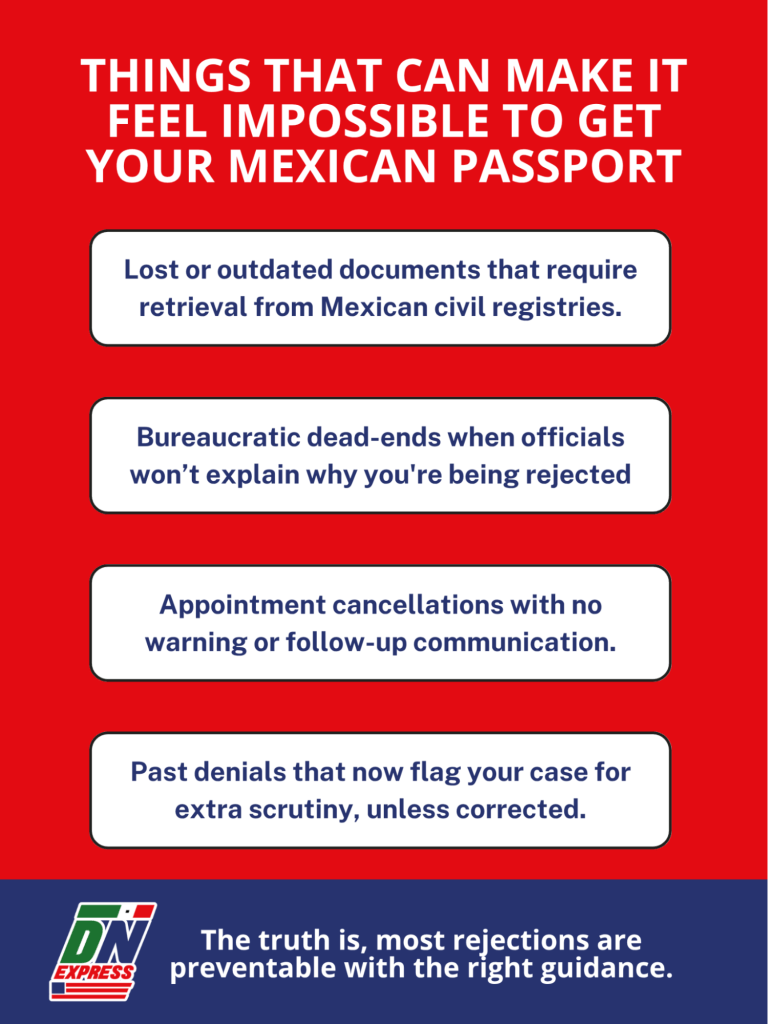
FAQ
Some frequent questions about a work visa in mexico:
How easy is it to get a work visa for Mexico?
It depends. If your employer is properly registered with INM and your paperwork is accurate, approval is usually straightforward.
Delays often come from missing documents or consulate backlogs.
Am I allowed to work in Mexico as a U.S. citizen?
Yes, but only with the right legal status. U.S. citizens cannot work on a tourist visa. You must hold either a Temporary Resident Visa with work authorization or Permanent Residency.
How much is a work visa?
Fees vary by consulate but are generally $150–$300 USD, plus any costs for translations, apostilles, or document collection.
Can I convert a tourist visa to a work visa?
No. The application must begin abroad at a Mexican consulate after your employer has secured the INM approval. You cannot change a tourist permit into a work visa from inside Mexico.
Are Mexican visas hard to get?
Not if you follow the process. As long as your employer is compliant with INM and you present consistent, legalized documents, most applicants are approved.
How do I move to Mexico from the U.S.?
You have multiple options:
- A work visa sponsored by a Mexican employer.
- Family residency through a Mexican parent, spouse, or child.
- Economic solvency residency, proving stable income or savings.
Is it easy to get temporary residency in Mexico?
Yes, if you qualify. A valid job contract, financial solvency, or family connection makes the process much smoother.
